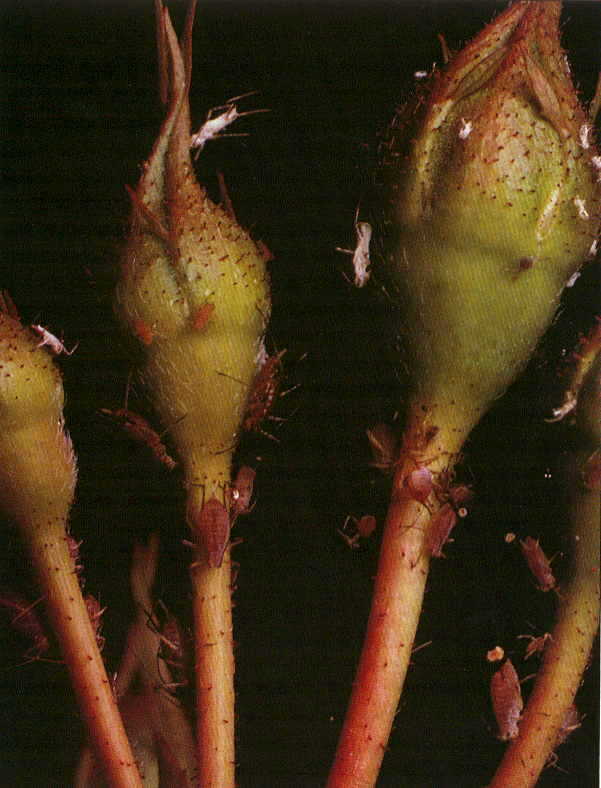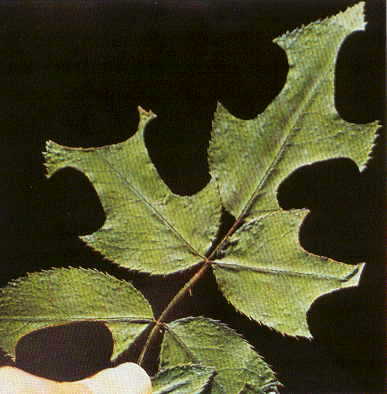
Recognizing Insects
Like diseases, there are several type insects and other small pests that rosarians will need to be familiar with. In order to treat the problems associated with these pest, you need to know what your dealing with. Some of these pest are large enough to see with the naked eye and others are very small. The larger ones are easier to identify and treat. The smaller are more elusive and can only be identified by the symptoms they leave. The following are some signs that will help in identifying some types of insect infestations that may be encountered. Keep in mind this is not an exhaustive list, however, it will get you started in the right direction. There may be some type insects that are hard to identify, in this case you may be able to enlist the help of your county extension service.
Control of insects is very different than that of diseases. Disease control is primarily preventative in nature. Spraying for insects should be done when the symptoms occur. Insecticides, sprays used to control insects, are usually harder on the plants than fungicides. They are also more dangerous for humans to handle. Another reason is that there is no reason to spray for bugs if there is no insect problem. It is very important to look at your plants often to catch any infestations early. Once they are eradicated the insect spray program can be stopped.
CANE BORERS
CATERPILLARS
JAPANESE BEETLES
LEAFCUTTER BEES
LEAFHOPPERS
MIDGE
ROSE SCALE
ROSE SLUGS
SPIDER MITES

CANE BORERS look like a caterpillar and can measure up to 1 inch long. These insects will enter the canes and usually cause them to swell where they are. Borers will cause the foliage to be small or sparse, and cause the leaves to turn yellow, wilt and die. Growth will slow or stop as the tips of the canes wilt. Cane Borers are a moderately serious insect pest. The plans can be treated by pruning away the cane below the infested area and discarding it. In areas where borers are common the canes can be sealed after pruning with tree wound paint, orange shellac, or water-insoluble glue to keep the borers out.
CATERPILLARS are greenish or yellowish wormlike larvae of various insects in differing sizes. They are usually visible on the plants. Caterpillars should be suspected when you see large holes appear in the leaves and the entire plant can be consumed. Caterpillars can do serious damage. These insects can be picked off the plant and destroyed. They can also be controlled by spraying with a contact insecticide such as Sevin® or a systemic insecticide such as Orthene®.
JAPANESE BEETLES should be suspected if you notice small round holes in the flowers or leaves. These insects are ½” long with hard shells of copper and green are visible. These insects tend to be attracted to flowers that are light colored. This is a very common insect especially in the Eastern half of the country. The best prevention for Japanese Beetles is a weed free garden. If not many are present they can be picked off by hand. If the rose garden has a large infestation they can also be controlled by spraying with a contact insecticide such as Sevin® or a systemic insecticide such as Orthene®.

LEAFHOPPERS should be suspected if the leaves turn yellow, starting at the edges, or are speckled with tiny dots. The leaves will eventually curl p and die. Leafhoppers are a wedge shaped insect colored light green, yellow, white, or gray and are visible. These insects jump quickly when disturbed. Leafhoppers are widespread and do the most damage in the fall. Remove any damaged leaves and spray with a contact insecticide such as Sevin® or a systemic insecticide such as Orthene®. In the fall rake up all the leaves, and weeds to destroy since the leafhopper eggs may be attached to them and can overwinter on this debris.

ROSE SCALE causes plants to stop growing and the growing tips will die back. The leaves will fall off the plant and there will be few flowers, if any. Clusters of round or oval insects with crusty whit, gray, or brown shells that are barely visible on the canes will appear. Rose scale is a moderately serious problem all across the nation. Prune away any infected area and discard. If infestations appear spray canes with insecticidal soap, Malathion, or Orthene® until symptoms are gone.


THRIPS will cause the leaves to curl, and the leaf margins will tun white, yellow, or brown. The flower buds will become discolored and bend over. The buds may not pen. The petals that do not open may have bumpy petals streaked in brown. The insects are very small and difficult to see. White and pastel roses are the most susceptible to thrips. To eradicate, spray the tops of the bushes with an insecticide such as Diazinon, Sevin®, Malathion, or Orthene®. Also spray the soil around the plants to kill any young thrips before they mature.
About Rose Bushes
Blue Roses
Fresh Roses
Long Stem Cookie Roses
Pink Roses
Purple Roses
Red Roses
Rose Bouquets
Rose Tshirts
Send Roses
Sending Red Roses
White Roses
Yellow Roses
Rose Growing Tips
Cold Protection for Roses
Recognizing Rose Diseases
Roses FAQ
Rose Ground Preparation
Recognizing Insects on Roses
Rose Planting Guide
Care
Crafts
Growing Roses
History
Landscaping
Miscellaneous Rose Info
News
Rose Bouquets
Rose Bowl
types of roses
Varieties